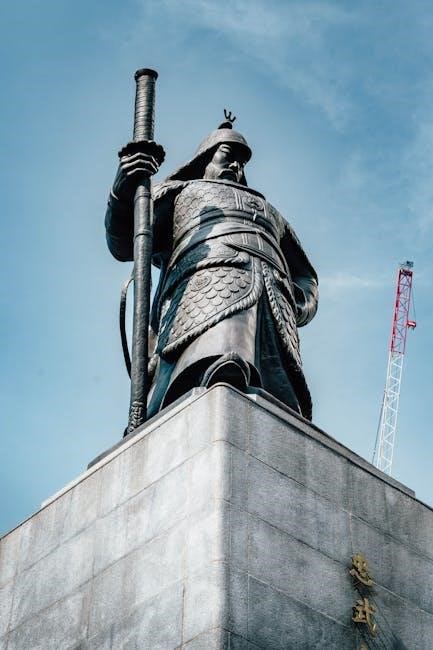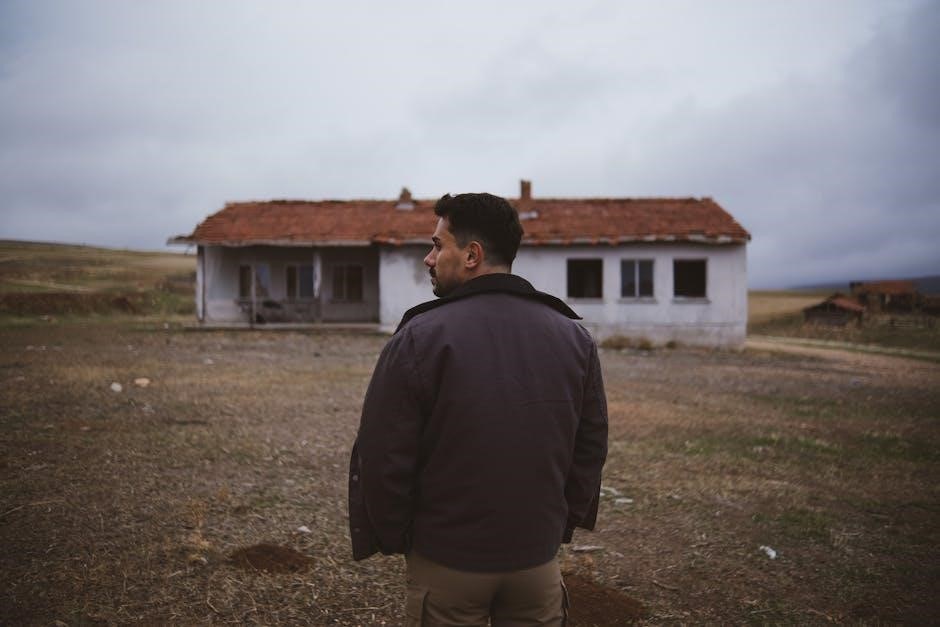Joseph Campbell, a renowned mythologist, introduced the concept of the Hero’s Journey, a universal storytelling framework. His work, The Hero with a Thousand Faces, explores the monomyth, a cross-cultural pattern in hero myths, influencing literature, film, and psychology.
Who is Joseph Campbell?
Joseph Campbell was a renowned American mythologist and scholar, best known for his groundbreaking work on comparative mythology. Born in 1904, Campbell dedicated his life to studying myths, legends, and their universal patterns. His seminal book, The Hero with a Thousand Faces, introduced the concept of the monomyth, a cross-cultural narrative structure he called the Hero’s Journey. Campbell’s work has profoundly influenced fields such as literature, film, and psychology, offering insights into the shared human experiences reflected in myths worldwide.
The Concept of the Hero’s Journey
The Hero’s Journey, as conceptualized by Joseph Campbell, is a universal narrative pattern that describes the transformative quest of a hero. This monomyth outlines the stages a hero undergoes, from the Ordinary World to the Return with the Elixir. It captures the essence of human struggle, growth, and triumph, transcending cultural boundaries. Campbell’s framework has become a cornerstone in storytelling, inspiring countless works in literature, film, and beyond, offering a deep understanding of the shared human experience.
The Significance of the Monomyth
The monomyth, a term popularized by Joseph Campbell, represents a universal narrative pattern that unites hero stories across cultures and time. It captures the essence of human experience, reflecting shared struggles, aspirations, and transformations. This timeless framework transcends cultural boundaries, offering insights into the collective unconscious. The monomyth’s significance lies in its ability to resonate with audiences, providing a shared language for storytelling and personal growth. Its enduring appeal continues to inspire art, psychology, and philosophy, making it a cornerstone of modern understanding.
The Hero’s Journey: A Universal Storytelling Framework
Joseph Campbell’s Hero’s Journey is a universal storytelling framework, offering a cross-cultural narrative structure that resonates deeply with human experience, inspiring art, psychology, and philosophy.
Definition and Overview
The Hero’s Journey, as defined by Joseph Campbell, is a universal storytelling framework that outlines the transformative quest of a hero. It is rooted in the monomyth, a cross-cultural pattern found in myths worldwide. The journey consists of stages such as the Ordinary World, the Call to Adventure, and the Return with the Elixir, symbolizing personal growth and transformation. This concept, detailed in Campbell’s works like The Hero with a Thousand Faces, has become a cornerstone in understanding narrative structures across cultures and time.

Key Stages of the Hero’s Journey
The Hero’s Journey, as outlined by Joseph Campbell, consists of a sequence of stages that the hero undergoes; These include the Ordinary World, where the hero begins their story, followed by the Call to Adventure, which disrupts their normal life. The hero may initially Refuse the Call before meeting a Mentor who aids them. They then Cross the Threshold into the special world, facing Tests, Allies, and Enemies. The journey culminates in the Ordeal and the Reward, leading to the Return with the Elixir, symbolizing transformation and fulfillment.
The Relevance Across Cultures and Time
Joseph Campbell’s Hero’s Journey is a timeless and universal framework, appearing in myths, legends, and stories across cultures and eras. From ancient Greek myths to modern films, its themes resonate deeply, reflecting shared human experiences. The monomyth transcends cultural boundaries, connecting people through common struggles and aspirations. Its enduring relevance lies in its ability to capture the essence of transformation and growth, making it a powerful tool for understanding both individual and collective journeys.

The Monomyth: Campbell’s Groundbreaking Concept
Joseph Campbell’s monomyth represents a universal narrative pattern found in hero stories worldwide. It captures the essence of transformative journeys, rooted in comparative mythology and human experience.
Origins and Development of the Monomyth
Joseph Campbell’s concept of the monomyth emerged from his extensive research into comparative mythology. His seminal work, The Hero with a Thousand Faces, laid the foundation by identifying universal patterns in hero myths across cultures. Campbell drew inspiration from Carl Jung’s archetypes and the collective unconscious, refining his ideas over decades. The monomyth’s origins trace back to ancient myths, folklore, and legends, reflecting shared human experiences and psychological truths. This framework has since become a cornerstone in understanding storytelling and its cultural significance.
Common Patterns in Hero Myths
Joseph Campbell identified universal patterns in hero myths, revealing a shared human experience. These narratives often feature a hero who embarks on a transformative journey, facing challenges and mentors. The monomyth includes stages like the call to adventure, trials, and a triumphant return. Such patterns reflect psychological and cultural truths, transcending time and geography. Campbell’s work highlights how these archetypal stories resonate deeply, connecting individuals across diverse traditions and fostering a sense of collective understanding.
Impact on Modern Storytelling
Joseph Campbell’s Hero’s Journey has profoundly influenced modern storytelling, shaping narratives in film, literature, and beyond. Filmmakers like George Lucas drew inspiration from Campbell’s monomyth for Star Wars, while authors integrate its stages into character development. The framework’s universal appeal lies in its ability to resonate with audiences, making it a cornerstone of creative storytelling. Campbell’s ideas continue to inspire new generations of writers, directors, and creators, ensuring his legacy endures in contemporary media and beyond.
The Stages of the Hero’s Journey
The Hero’s Journey, as outlined by Joseph Campbell, consists of stages like the Ordinary World, Call to Adventure, Meeting the Mentor, and Return with the Elixir, forming a transformative narrative arc.
The Ordinary World
The Ordinary World is the initial stage of the Hero’s Journey, where the hero exists in a familiar, mundane environment. This stage establishes the hero’s normal life, highlighting their initial limitations and the comfort zone they are about to leave. It serves as a contrast to the extraordinary adventures that await, setting the stage for the Call to Adventure. This phase is crucial for audience connection, as it humanizes the hero and makes their eventual transformation relatable and impactful.
The Call to Adventure
The Call to Adventure disrupts the hero’s ordinary life, presenting a challenge or opportunity that beckons them to embark on a transformative journey. This stage often manifests as an unexpected event, message, or encounter that disrupts the hero’s routine. The call may evoke a sense of curiosity, duty, or longing, urging the hero to step beyond their comfort zone. It serves as the catalyst for the journey, initiating the hero’s movement toward the unknown and setting the story in motion.
Refusal of the Call
The Refusal of the Call occurs when the hero hesitates or declines the adventure due to fear, insecurity, or a sense of inadequacy. This stage highlights the hero’s initial reluctance to leave their comfort zone, often driven by a fear of the unknown or a sense of duty to their current life. The refusal underscores the hero’s humanity and sets the stage for the eventual acceptance of the journey, emphasizing the internal conflict and growth that precedes transformative action.
Meeting the Mentor
The Meeting the Mentor stage introduces a wise, experienced guide who aids the hero in understanding their journey. This figure, often a wise old man or woman, provides crucial advice, magical tools, or confidence, helping the hero overcome initial fears and doubts. The mentor embodies wisdom and experience, serving as a catalyst for the hero’s transformation. This encounter prepares the hero for the challenges ahead, offering both practical assistance and psychological support to embark on the adventure with renewed determination.
Crossing the Threshold
Crossing the Threshold marks the hero’s commitment to the adventure, leaving the Ordinary World behind. This stage involves a symbolic or literal act of crossing into the unknown, often accompanied by a point of no return. The hero must surrender old habits and embrace the challenges ahead. This transition signifies a willingness to face the unknown, demonstrating courage and determination. It is a pivotal moment where the hero fully engages with the journey, ready to confront the trials that await them in the Special World.
Tests, Allies, and Enemies
Tests, Allies, and Enemies is a critical stage where the hero faces challenges, forges alliances, and encounters adversaries. These trials refine the hero’s skills and reveal their character. Allies provide guidance, support, or magical aid, while enemies test the hero’s resolve. This phase prepares the hero for greater challenges ahead, fostering growth and resilience. The interactions with allies and enemies deepen the hero’s understanding of the Special World and their role within it, ultimately strengthening their determination to succeed.
Approach to the Inmost Cave
The Approach to the Inmost Cave is a pivotal stage where the hero nears a place of great fear or uncertainty. This phase symbolizes confrontation with inner demons and the unknown. The hero must summon courage, preparing for the impending ordeal. Psychological or emotional challenges arise, testing their resolve. This stage ensures the hero is ready to face the ultimate test ahead, marking a crucial step in their transformation and growth.
Ordeal
The Ordeal is the ultimate test, where the hero faces their greatest fear or challenge. This climactic stage often involves a life-or-death struggle, pushing the hero to their limits. It is here that the hero must confront their deepest doubts and weaknesses, emerging transformed. The Ordeal symbolizes the hero’s willingness to sacrifice and their capacity for courage in the face of overwhelming adversity, marking a pivotal moment of growth and self-discovery in their journey.
Reward (Seizing the Sword)
The Reward stage represents the hero’s triumph after overcoming the Ordeal. Here, they seize the treasure, whether literal or symbolic, such as wisdom, power, or love. This moment signifies the hero’s achievement and fulfillment of their quest’s primary goal. The reward often grants them the tools or insight needed for the journey ahead, symbolizing their growth and readiness to return to their ordinary world. It is a celebration of their perseverance and the realization of their potential.
The Road Back
The Road Back marks the hero’s transition from the special world to the ordinary world. After seizing the reward, the hero must navigate the challenges of returning home. This stage often involves a final confrontation or escape, testing the hero’s resolve and newfound power. The journey back symbolizes the hero’s readiness to reintegrate into their original world, bringing with them the wisdom, power, or knowledge gained. It is a bridge between the transformative experience and the hero’s reentry into society, completing the cycle of growth and adventure.
Resurrection
Resurrection is the climactic stage where the hero faces their ultimate test, often symbolizing a “death” and rebirth. This final ordeal pushes the hero to confront their deepest fears or weaknesses, emerging transformed and empowered. The resurrection represents a complete psychological or spiritual renewal, equipping the hero with the wisdom and strength needed to fulfill their destiny. It is the pinnacle of their journey, marking their readiness to return to the ordinary world as a changed individual.
Return with the Elixir
The final stage of the Hero’s Journey, Return with the Elixir, sees the hero bringing back the wisdom, power, or knowledge gained on their quest to benefit their community. This stage symbolizes the hero’s complete transformation and their ability to share the fruits of their journey. The elixir, whether literal or metaphorical, represents the hero’s gift to others, restoring balance and inspiring renewal. This step completes the cycle, as the hero reintegrates into society, fulfilling their ultimate purpose.

Cultural and Historical Context of the Hero’s Journey
The Hero’s Journey, as explored by Joseph Campbell, reflects universal cultural patterns, appearing in myths from various civilizations, highlighting humanity’s shared experiences and aspirations across time.
Mythological Roots
Joseph Campbell’s concept of the Hero’s Journey is deeply rooted in universal mythological themes. His work, The Hero with a Thousand Faces, identifies the monomyth, a shared narrative pattern across cultures. Drawing from Greek, Norse, and Native American myths, Campbell highlights the common archetypes and stages, such as the call to adventure and the ordeal, that appear in stories worldwide. This timeless structure reflects humanity’s collective unconscious, as proposed by Carl Jung, making the Hero’s Journey a cornerstone of mythological study.
Historical Evolution of Hero Stories
Joseph Campbell’s work reveals the historical evolution of hero stories, tracing their development from ancient myths to modern narratives. The monomyth, or Hero’s Journey, adapts across cultures and eras, reflecting societal values and human experiences. From Odysseus’s odyssey to modern-day heroes, the structure remains consistent, showcasing the timelessness of archetypal themes. Campbell’s research highlights how these stories evolve while retaining core elements, proving their universal relevance and enduring appeal across generations.

Cultural Variations and Commonalities
Joseph Campbell’s Hero’s Journey reveals both cultural variations and commonalities in hero myths worldwide. While stories adapt to unique traditions and values, the monomyth’s core structure remains consistent. From ancient Greek legends to African folktales, the hero’s transformative quest echoes universal themes of adventure, challenge, and self-discovery. Campbell’s work highlights how diverse cultures express shared human experiences, proving the monomyth’s timeless relevance and adaptability across societies and eras.

Psychological and Philosophical Insights
Joseph Campbell’s Hero’s Journey explores universal human experiences, drawing on Jungian archetypes and the collective unconscious. It reflects personal growth, transformation, and the quest for meaning, resonating deeply with psychological and philosophical inquiries into human nature and existence.
Jungian Archetypes and the Collective Unconscious
Joseph Campbell’s Hero’s Journey aligns with Carl Jung’s concept of archetypes and the collective unconscious, shared across cultures. Archetypes like the Hero, Mentor, and Shadow appear universally, reflecting deep psychological patterns. Campbell’s framework draws on these symbols, showing how they resonate with human experiences. This connection highlights the psychological depth of the Hero’s Journey, emphasizing universal truths and the process of individuation. The alignment with Jungian theory underscores the monomyth’s power in storytelling and personal transformation.
Personal Growth and Transformation
The Hero’s Journey, as outlined by Joseph Campbell, serves as a powerful metaphor for personal growth and transformation. The stages of the journey—departure, initiation, and return—mirror the process of self-discovery and evolution. Through facing challenges and overcoming fears, the hero embodies the universal human quest for meaning and transformation. Campbell’s framework highlights the potential for individuals to undergo profound change, aligning with the idea that the journey is not just external but deeply internal, fostering self-awareness and spiritual awakening.
Universal Human Experiences
The Hero’s Journey, as conceptualized by Joseph Campbell, reflects universal human experiences such as the struggle for identity, the quest for meaning, and the overcoming of adversity. These themes transcend cultural boundaries, resonating deeply with individuals across time and space. Campbell’s framework highlights the shared human condition, where personal and collective journeys mirror the stages of the monomyth. This universality underscores the profound relevance of the Hero’s Journey in understanding human nature and the eternal quest for self-discovery and transformation.

Modern Applications of the Hero’s Journey
The Hero’s Journey inspires modern storytelling in film and literature, while its principles are applied in psychology, self-help, and leadership, offering timeless guidance for personal and professional growth.
In Film and Literature
Joseph Campbell’s Hero’s Journey has profoundly influenced modern storytelling. Filmmakers like George Lucas drew inspiration from Campbell’s work, shaping iconic narratives such as Star Wars. Similarly, authors like J.R.R. Tolkien wove monomyth patterns into The Lord of the Rings. The framework’s stages, from the call to adventure to the return with the elixir, provide a timeless structure for creating compelling characters and stories. This universal appeal ensures the Hero’s Journey remains a cornerstone in both cinematic and literary storytelling, resonating with audiences across generations.
In Psychology and Self-Help
Joseph Campbell’s Hero’s Journey has become a powerful tool in psychology and self-help, offering a framework for personal growth and transformation. It aligns with Carl Jung’s concept of individuation, where individuals integrate their psyche. The journey’s stages, from the call to adventure to resurrection, mirror the process of self-discovery and overcoming inner challenges. Many self-help books and therapies use this model to guide individuals toward fulfilling their potential, emphasizing the universal human quest for meaning and transformation.
In Business and Leadership
Joseph Campbell’s Hero’s Journey has inspired leaders to embrace transformative challenges. By framing leadership as a heroic quest, individuals can navigate organizational changes, inspire teams, and drive innovation. The journey’s stages—such as the call to adventure and overcoming trials—mirror leadership development, fostering resilience and vision. This universal narrative empowers leaders to craft compelling stories, aligning their teams with a shared purpose, and driving success in dynamic business environments.
Joseph Campbell’s Legacy
Joseph Campbell’s work revolutionized storytelling, inspiring films, literature, and psychology. His books, like The Hero with a Thousand Faces, remain influential, shaping contemporary thought and creativity globally.
Major Works and Contributions
Joseph Campbell’s seminal work, The Hero with a Thousand Faces, introduced the concept of the monomyth, a universal narrative pattern. He also authored The Masks of God series, exploring mythological themes across cultures. His books, such as Myths to Live By and The Historical Atlas of World Mythology, further cemented his legacy as a leading mythologist. Campbell’s work has profoundly influenced storytelling, psychology, and philosophy, leaving a lasting impact on modern thought and creativity.
Influence on Contemporary Thought
Joseph Campbell’s theories on the Hero’s Journey have profoundly shaped modern storytelling, inspiring filmmakers, writers, and psychologists. His ideas on universal myths and archetypes continue to influence fields like psychology, self-help, and leadership. Campbell’s work bridges cultural divides, offering insights into shared human experiences. His vision of a unified narrative structure remains a cornerstone of contemporary thought, inspiring new generations to explore the depths of myth and its relevance in understanding human consciousness and storytelling.
Continued Relevance in the Digital Age
Joseph Campbell’s Hero’s Journey remains a cornerstone of modern storytelling, even in the digital age. Its universal themes resonate across media, from video games to social media narratives. The monomyth’s structure continues to inspire creators, offering a timeless framework for personal and collective transformation. With the rise of digital platforms, Campbell’s ideas are more accessible than ever, ensuring their relevance in understanding human experiences and storytelling in the 21st century.
Joseph Campbell’s Hero’s Journey remains a timeless framework for understanding storytelling and human transformation. For deeper exploration, resources like PDFs and online analyses offer comprehensive insights into his work.
Final Thoughts on the Hero’s Journey
Joseph Campbell’s Hero’s Journey is a timeless framework that transcends cultures and time, offering profound insights into human transformation and storytelling. Its universal appeal is evident in its influence on literature, film, psychology, and beyond. For those seeking deeper understanding, numerous PDF resources and analyses are available, providing comprehensive insights into Campbell’s seminal work.
Resources for Further Study
For deeper exploration, numerous resources are available, including PDF guides outlining the Hero’s Journey stages. Joseph Campbell’s seminal works, such as The Hero with a Thousand Faces and The Hero’s Journey, provide foundational insights. Online platforms like TED-Ed and YouTube channels such as StudioBinder Academy offer engaging analyses. Additionally, downloadable PDFs and e-books summarize Campbell’s theories, making his concepts accessible for modern learners and storytellers alike.

